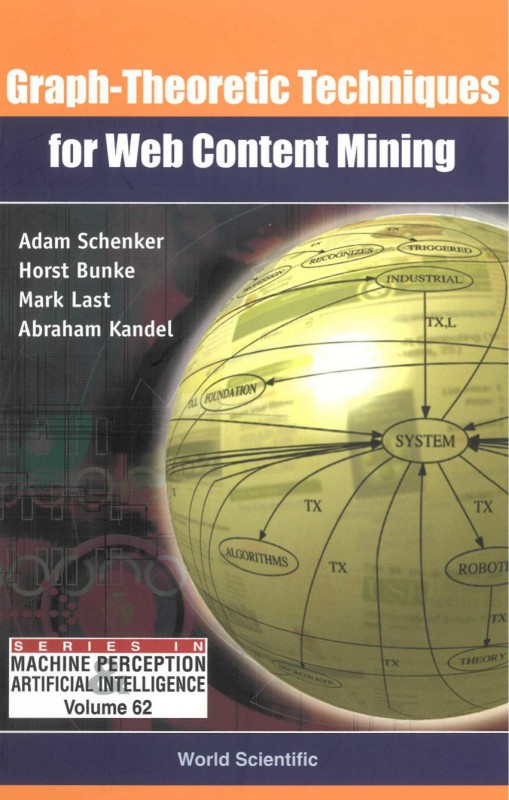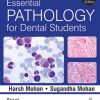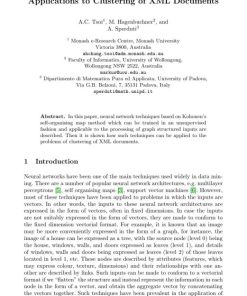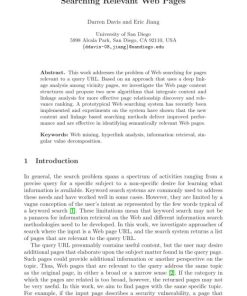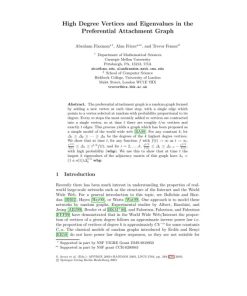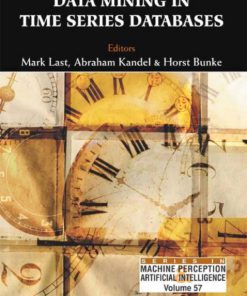Graph theoretic Techniques for Web Content Mining 1st edition by Adam Schenker, Horst Bunke, Mark Last, Abraham Kandel ISBN 9812563393 978-9812563392
$50.00 Original price was: $50.00.$25.00Current price is: $25.00.
Authors:Schenker, Adam. , Series:Computer Science [342] , Author sort:Schenker, Adam. , Languages:Languages:eng , Published:Published:Apr 2006 , Publisher:World Scientific
Graph-theoretic Techniques for Web Content Mining 1st edition by Adam Schenker, Horst Bunke, Mark Last, Abraham Kandel – Ebook PDF Instant Download/Delivery. 9812563393 978-9812563392
Full download Graph-theoretic Techniques for Web Content Mining 1st edition after payment
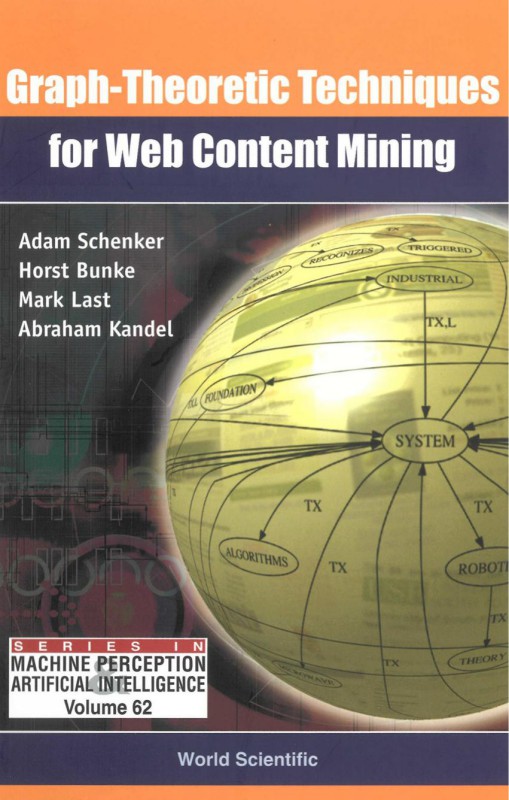
Product details:
ISBN 10: 9812563393
ISBN 13: 978-9812563392
Author: Adam Schenker, Horst Bunke, Mark Last, Abraham Kandel
This book describes exciting new opportunities for utilizing robust graph representations of data with common machine learning algorithms. Graphs can model additional information which is often not present in commonly used data representations, such as vectors. Through the use of graph distance — a relatively new approach for determining graph similarity — the authors show how well-known algorithms, such as k-means clustering and k-nearest neighbors classification, can be easily extended to work with graphs instead of vectors. This allows for the utilization of additional information found in graph representations, while at the same time employing well-known, proven algorithms.To demonstrate and investigate these novel techniques, the authors have selected the domain of web content mining, which involves the clustering and classification of web documents based on their textual substance. Several methods of representing web document content by graphs are introduced; an interesting feature of these representations is that they allow for a polynomial time distance computation, something which is typically an NP-complete problem when using graphs. Experimental results are reported for both clustering and classification in three web document collections using a variety of graph representations, distance measures, and algorithm parameters.In addition, this book describes several other related topics, many of which provide excellent starting points for researchers and students interested in exploring this new area of machine learning further. These topics include creating graph-based multiple classifier ensembles through random node selection and visualization of graph-based data using multidimensional scaling.
Graph-theoretic Techniques for Web Content Mining 1st Table of contents:
Preface
- Introduction to Web Content Mining
- Importance of Graph-theoretic Techniques in Web Mining
- Who This Book is For
- Structure of the Book
- Acknowledgments
Part I: Introduction to Web Content Mining and Graph Theory
-
Introduction to Web Content Mining
- What is Web Content Mining?
- Types of Web Data: Text, Multimedia, Structured, and Semi-structured Data
- Challenges in Web Content Mining
- Applications of Web Content Mining: Information Retrieval, Recommendation Systems, and Social Media Analysis
-
Fundamentals of Graph Theory
- Basic Concepts in Graph Theory: Vertices, Edges, and Graphs
- Types of Graphs: Directed, Undirected, Weighted, and Bipartite
- Graph Traversal: Depth-First Search (DFS), Breadth-First Search (BFS)
- Graph Connectivity, Components, and Shortest Path Algorithms
- Network Flow and Graph Coloring Techniques
-
Graph Representation of Web Content
- Web as a Graph: Hyperlinks as Edges and Web Pages as Nodes
- Representation of Web Structure: Directed Acyclic Graphs (DAG), Web Graphs, and Link Analysis
- Web Crawling and Graph Construction
- Graph-based Features for Content Extraction
- Visualizing Web Content Graphs
Part II: Graph-theoretic Techniques for Web Content Mining
-
Graph-based Data Mining Techniques
- Graph Construction and Preprocessing for Mining
- Mining Graphs for Patterns: Frequent Subgraphs, Graph Isomorphism
- Graph-based Clustering Algorithms
- Link Prediction and Relationship Discovery
- Community Detection in Web Graphs
-
PageRank and Link Analysis
- Introduction to Link Analysis: Importance of Links in Web Mining
- The PageRank Algorithm: Calculation and Application
- Extensions of PageRank: Weighted PageRank, Topic-sensitive PageRank
- HITS (Hyperlink-Induced Topic Search) Algorithm
- Evaluating Web Graph Centrality Measures
-
Graph-based Classification Techniques for Web Content
- Graph-based Classification Overview
- Supervised Learning in Web Content Mining
- Graph-based Feature Selection and Label Propagation
- Semi-supervised Learning and Graph-based Methods
- Case Studies: Text Classification Using Graph-based Techniques
-
Graph Matching and Similarity Measures
- Graph Matching Techniques for Content Comparison
- Similarity Measures for Graphs: Edit Distance, Graph Kernels
- Applications in Duplicate Detection and Web Page Clustering
- Graph Alignment for Data Integration and Web Content Merging
-
Graph-based Topic Modeling and Semantic Web
- Topic Modeling: Graphical Models for Text Mining
- Latent Semantic Analysis (LSA) and Latent Dirichlet Allocation (LDA)
- Constructing Topic Graphs for Web Content Analysis
- Graph-based Semantic Web and Ontologies
- Applications in Web Search and Information Retrieval
Part III: Applications of Graph-theoretic Techniques in Web Content Mining
-
Social Network Analysis and Web Mining
- Social Networks as Graphs: Nodes as Individuals, Edges as Relationships
- Community Detection in Social Media
- Influence Propagation and Opinion Mining
- Graph-based Algorithms for Social Media Analysis (Twitter, Facebook, etc.)
- Case Studies in Social Network Graph Mining
-
Recommender Systems Using Graph-based Methods
- Collaborative Filtering and Graph-based Approaches
- Building Item-User Graphs for Recommendation
- Graph-based Techniques for Personalized Web Content
- Hybrid Recommendation Systems: Combining Graphs with Other Methods
- Real-World Applications: E-commerce, Streaming, and News Recommendation
-
Web Content Extraction and Information Retrieval
- Graph-based Techniques for Web Scraping and Data Extraction
- Link-based Web Search and Graph Search Algorithms
- Extracting Knowledge from Web Pages Using Graph Models
- Query Expansion and Ranking with Graph-based Methods
- Case Studies in Web Search and Content Retrieval
-
Graph Mining for Web Security and Fraud Detection
- Detecting Web Spam and Link Farming Using Graph-based Techniques
- Anomaly Detection in Web Graphs: Fraudulent Activities
- Graph-theoretic Models for Trust and Reputation Systems
- Using Graphs for Detecting Phishing and Malware Websites
- Privacy Concerns and Security Implications in Web Graph Mining
Part IV: Advanced Topics in Graph-based Web Content Mining
-
Scalable Graph Mining for Large Web Data
- Challenges in Scaling Graph Mining Algorithms
- Distributed Graph Processing: MapReduce and Hadoop
- Parallelization and GPU-based Approaches for Large-Scale Graph Mining
- Data Streaming and Real-time Graph Mining for Web Content
- Efficient Graph Storage and Indexing Techniques
-
Graph-based Machine Learning for Web Content
- Machine Learning Techniques Leveraging Graph Structures
- Graph Neural Networks (GNNs) for Web Mining
- Graph Convolutional Networks (GCNs) in Web Content Analysis
- Case Studies in Web Content Classification Using GNNs
- Future Trends: Deep Learning and Graph Theory
-
Challenges and Future Directions
- Handling Noisy and Incomplete Data in Web Graphs
- Privacy and Ethical Issues in Web Graph Mining
- The Role of AI and Graph Theory in Future Web Content Mining
- Potential Applications in Autonomous Web Agents, AI, and IoT
- Emerging Research Areas: Graph Databases, Graph Databases for Big Data
References
- Key Research Papers, Books, and Articles for Further Reading
Index
People also search for Graph-theoretic Techniques for Web Content Mining 1st:
web graph mining
web content mining techniques
web content mining approach
graph properties of web mining
theoretical framework for text mining

